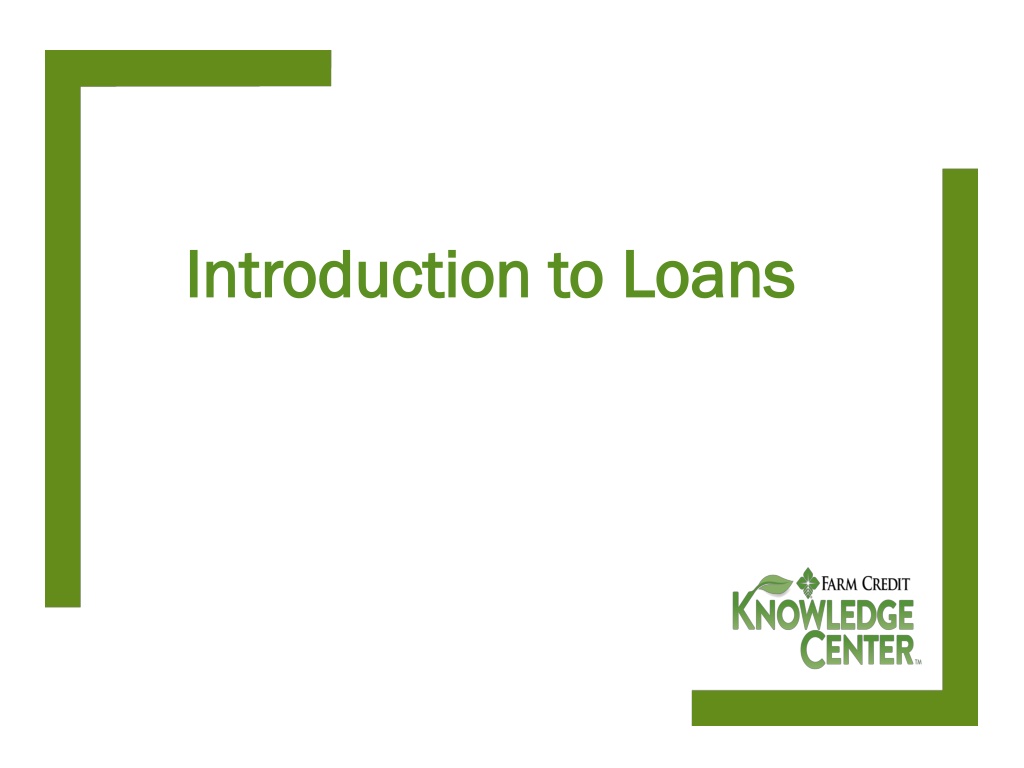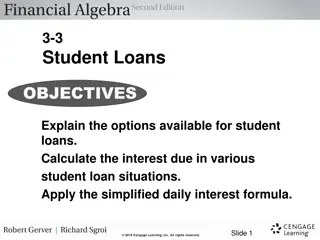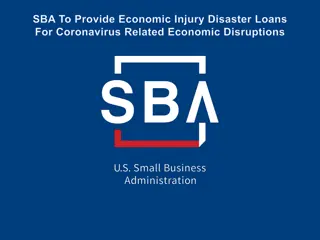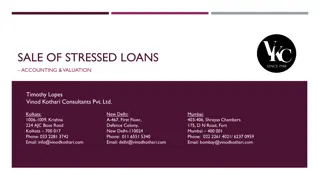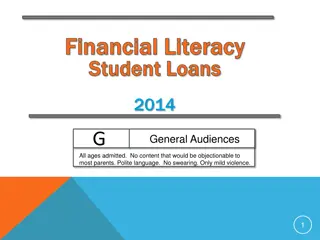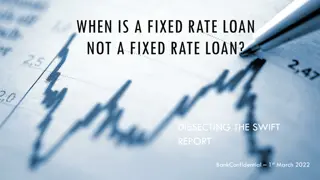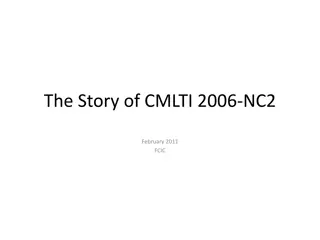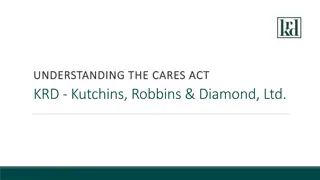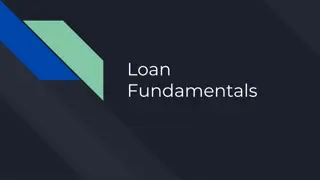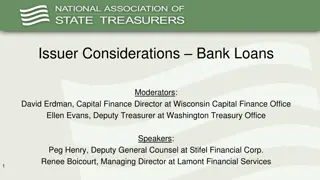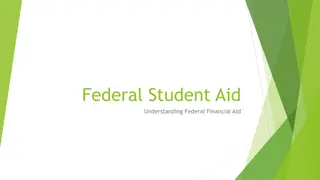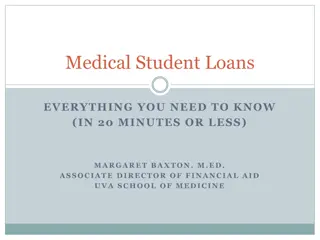Understanding Loans and Alternatives for Businesses
A loan is a debt provided by a lender to purchase personal or business assets, repaid in installments over time. Businesses utilize loans to acquire expensive assets and improve profitability. Alternatives such as using cash on hand or leasing assets can also be beneficial, each with its own advantages and disadvantages. This guide covers the basics of loans and explores alternative options for managing business finances effectively.
Download Presentation

Please find below an Image/Link to download the presentation.
The content on the website is provided AS IS for your information and personal use only. It may not be sold, licensed, or shared on other websites without obtaining consent from the author. Download presentation by click this link. If you encounter any issues during the download, it is possible that the publisher has removed the file from their server.
E N D
Presentation Transcript
Introduction to Loans Introduction to Loans
What is a Loan? What is a Loan? A loan is a debt (liability) to purchase an asset Provided by a lender To a borrower Repaid in regular payments (installments) over time Loans are used to: Purchase personal assets House, car, college education, personal assets Purchase business assets Land, buildings, vehicles, equipment, inventories Pay certain business expenses Rent, utilities, hired labor
Why Do Businesses Use Loans Why Do Businesses Use Loans To purchase expensive assets Most businesses don t have enough money to pay in cash To purchase assets today vs waiting to save enough money For emergencies When you don t have enough cash To improve the profitability of the business This is called financial leverage
Alternatives to Loans Alternatives to Loans Instead of loans, a manager can use: Cash on hand Do not use all of your cash and savings Leave enough cash to meet your monthly expenses & emergency needs! Leases A lease is a rental agreement You can lease: Equipment Structures and/or land Livestock
Leases Leases Advantages You can lease the exact asset that you need You can lease it for a specified period of time And then return it to the leasing company Ex. You only need a delivery van for 6 months out of the year You can lease it for 6 months instead of buying it and having it sit idle for the rest of the year You may get more tax advantages by leasing vs buying Leasing may require less out-of-pocket cash Lower down payment, fees, etc.
Leases Leases Disadvantages You cannot make major alterations to leased assets Paint it, add new fixtures, etc. Because you don t actually own the asset It may be hard to lease the asset you want There may be over-use fees Mileage limits, hour limits, etc. These are usually expensive Getting out of a lease may be very expensive Versus simply selling an asset that you own
Terms Terms Down Payment Cash that is paid by the borrower at the time of purchase Down payments are usually 10-20% of the purchase price Principal Principal is the term for the amount of the loan Principal = loan amount Principal is a liability on the balance sheet
Terms Terms Collateral The assets that are pledged to the lender in case the borrower cannot repay the loan If so, these assets will be repossessed by the lender Example: You have an auto loan for your car. The car is the collateral for the loan. If you cannot make your loan payments, the lender may repossess the car. NOTE: Lenders do NOT want to repossess assets. They want borrowers to be able to repay the loans in full.
Down Payments Down Payments Lenders usually require the borrower to make a down payment Usually between 10-20% of the purchase price Example: You want to buy a $25,000 trailer. The lender requires a 20% down payment. Down payment = $5,000 ($25,000 x 20%) Loan Principal = Purchase Price Down Payment = $25,000 - $5,000 = $20,000 loan
Types of Loans Types of Loans Personal Loans Auto Loans Repaid over 3-7 years Student Loans Repaid over 10-20 years Home Mortgages Repaid over 15-30 years Credit Cards A credit limit is set the maximum you can borrow You can borrow up to that limit and repay the principal on in a flexible manner Should be repaid as soon as possible (< 1 year)
Types of Loans Types of Loans Business Loans Equipment Loans Repaid over 3-10 years Real Estate Loans To purchase land, buildings, facilities Repaid over 15-30 years Operating Loan Used to purchase or pay for operating inputs Repaid within a 1-year period Operating Line of Credit Acts like a credit card
Loan Applications Loan Applications Borrowers need to submit a loan application Helps determine their ability to repay the loan Determines if the loan is a good idea for both parties (borrower and lender) Typically includes: Balance Sheet(s) Income Statement(s) or proof of income Credit history Credit score
Interest Payments Interest Payments Interest is the cost of borrowing money Stated as APR (Annual Percentage Rate) Simple Interest You only owe interest on the amount of principal you still owe the lender Interest calculation Interest = Principal Owed x APR
Interest Calculation Example Interest Calculation Example You borrow $50,000 to buy a delivery truck The loan is at 5% APR for 4 years Interest = Principal Owed x APR = $50,000 x 5% = $2,500 2 years later, you still owe $26,200 on the loan Interest = $26,200 x 5% = $1,310
Loan Payments Loan Payments Several types of loan repayment plans Most common is level payment The payment stays the same each period Example: Car loan has payments of $400/month $400/month for the life of the loan Loan payments consist of interest and principal All of the interest owed since the last payment A portion of the principal
Components of a Loan Payment Components of a Loan Payment Assume your annual loan payment is $5,000 and you owe $3,000 of interest since the last loan payment was made Payment = $5,000 Interest = $3,000 Principal = $3,000 ($5,000 - $3,000)
Calculating Annual Loan Payments Calculating Annual Loan Payments Using the Time Value of Money Tables Table 3 Annuity Factors: Annual Loan Payments Need to know: Interest Rate (APR) Life of the loan in years (the term of the loan) Amount of the loan (principal) Find the loan payment factor in Table 3 Example: 10-year loan at 6% APR Find the 6% column of the table Go down to the 10 row (n = 10 in left column) Factor = 0.1359
Calculating Loan Payments Calculating Loan Payments Multiply the loan principal by the factor For a $40,000 loan at 6% for 10 years Annual Payment = $40,000 x 0.1359 = $5,436/year You will repay the loan and all interest in full if you pay $5,436/year for the next 10 years This is called amortizing the loan Amortizing = paying back the principal slowly over time
Practice Using Table 3 Practice Using Table 3 Find the annual loan payment factors for the following loans: 8% APR for 20 years 4% for 30 years 7% for 8 years
Practice Using Table 3 Practice Using Table 3 Find the annual loan payment factors for the following loans: 8% APR for 20 years factor = 0.1019 4% for 30 years factor = 0.0578 7% for 8 years factor = 0.1675
Breaking Down a Loan Payment Breaking Down a Loan Payment Remember, loan payments contain interest and principal For the $40,000 loan at 6% for 10 years For the 1stloan payment: Annual Loan Payment = $5,436 Interest Due = $40,000 x 6% = $2,400 Principal Due = $5,436 - $2,400 = $3,036 You will still owe $36,964 after you make this first payment $40,000 principal borrowed - $3,036 principal due
Monthly Loan Payments Monthly Loan Payments Use Table 4 Monthly Payments Required to Amortize a $1,000 Loan NOTE: we use this table differently than Table 3 Step 1. Find the factor in the same manner Assume a 5-year loan at 5.5% APR Monthly Payment Factor = 19.10 This means the monthly payment for a $1,000 loan at 5.5% APR for 5 years is $19.10/month
Monthly Loan Payments Monthly Loan Payments Step 2. Divide the loan principal by $1,000 Example: $20,000 car loan $20,000 / $1,000 = 20 Step 3. Multiply the factor from Step 1 by the answer from Step 2. Monthly Payment = 19.10 x 20 = $382/month
Using a Spreadsheet Using a Spreadsheet It is easy to calculate loan payments on a spreadsheet Just enter the information for the loan The spreadsheet does the rest! Find the monthly payment for a $55,000 tractor loan at 5.25% APR for 6 years Loan Principal = $55,000 Interest Rate = 5.25 Life of Loan = 6 Payment = $892.16 Payments/Year = 12
Using a Spreadsheet Using a Spreadsheet Calculate the quarterly payment for a $30,000 loan at 6.25% APR for 4 years Loan Principal = $30,000 Interest Rate = 6.25 Life of Loan = 4 Payment = $2,133.67 Payments/Year = 4 Look at the table below the calculator to see how the interest and principal payments change for each payment
